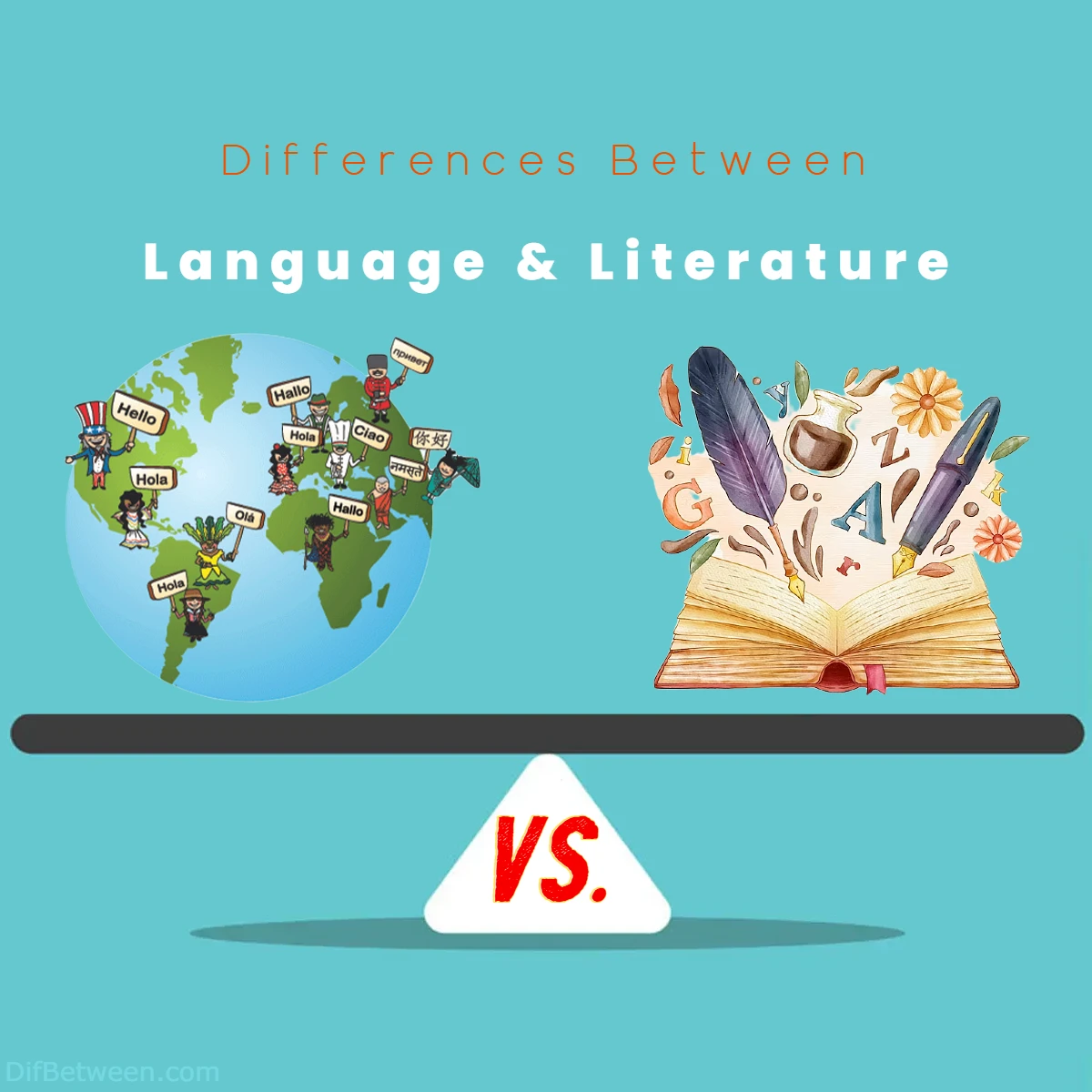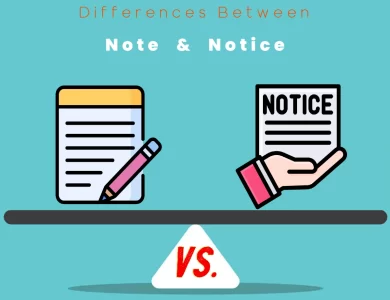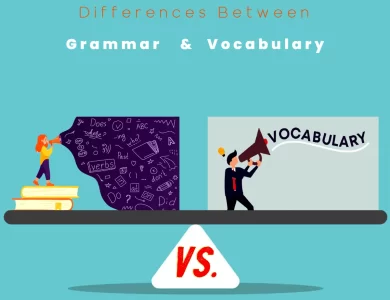
| Aspect | Language | Literature |
|---|---|---|
| Definition | A means of communication, spoken and written. | Artistic and structured use of language. |
| Form | Flexible, everyday use. | Structured, artistic expression. |
| Purpose | Communication and information exchange. | Artistic expression, storytelling, reflection. |
| Structure | Varied, context-dependent. | Follows literary conventions and structures. |
| Examples | Conversations, emails, reports. | Novels, poems, plays, essays. |
| Emotion and Aesthetics | Pragmatic and emotionally neutral. | Evokes emotions, focuses on aesthetics. |
| Timelessness | Dynamic, evolving over time. | Enduring, reflects specific eras. |
| Subjectivity and Interpretation | Objective and clear communication. | Open to multiple interpretations, uses literary devices. |
| Creators and Consumers | Collective creation, shared resource. | Individual authors, collective audience. |
| Medium of Expression | Spoken and written language. | Primarily written, can also be spoken. |
| Influence on Culture | Reflects cultural norms. | Challenges and reflects cultural norms. |
| Educational Role | Foundation for education. | Fosters creativity and critical thinking. |
| Legacy and Endurance | Transitory, spoken words vanish. | Time-tested, continues to captivate. |
| Influence on Society | Reflects societal norms and values. | Provokes social change and commentary. |
| Interplay Between | Serves as the canvas for literary works. | Shapes language, introduces new expressions. |
Language, the versatile chameleon of communication, is our everyday companion, a tool we wield effortlessly to convey thoughts, emotions, and information. It is the bridge that connects us, the mosaic of sounds and symbols that forms the foundation of human interaction. But what about literature? Ah, literature is the enchanted forest where language transforms into a vivid tapestry of words, conjuring emotions, transporting us to far-off realms, and leaving an indelible mark on our souls.
Differences Between Language and Literature
The main differences between Language and Literature lie in their fundamental purposes and expressions. Language serves as a versatile tool for everyday communication, both spoken and written, facilitating the conveyance of information and ideas. On the other hand, Literature elevates language into an art form, employing structured narratives, vivid imagery, and poetic devices to evoke emotions, provoke thought, and tell stories. While Language is a pragmatic means of conveying messages, Literature is an artistic endeavor that delves deep into the realms of human imagination and culture.
Defining Language and Literature
Language: The Foundation of Expression
At its core, language is the cornerstone of human communication. It serves as a means to convey thoughts, ideas, emotions, and information from one individual to another. It is the medium through which we express ourselves, share knowledge, and build connections. Language encompasses spoken, written, and even non-verbal forms of communication, making it a broad and encompassing concept.
Literature: The Artistic Manifestation of Language
Literature, on the other hand, can be seen as a subset of language, but with a creative twist. It is a structured and artistic use of language to evoke emotions, provoke thought, and tell stories. Literature encompasses various forms, such as novels, poems, short stories, plays, essays, and more. It’s where language transcends mere communication and becomes a vehicle for artistic expression and cultural preservation.
Form and Structure
Language: A Tool for Everyday Communication
Language, in its raw form, is a tool for everyday communication. It doesn’t adhere to specific rules or structures. It’s flexible and adaptive, allowing us to convey ideas in a manner that suits the context. The rules of language often vary based on the dialect, culture, and the specific situation. For instance, casual spoken language may include colloquialisms and slang, while formal written language follows stricter grammatical conventions.
Literature: Structured and Artistic Expression
Literature, in contrast, adheres to a structured framework. It incorporates elements like plot, characters, setting, and themes. These elements are carefully crafted to engage the reader’s imagination and emotions. Literary works often follow established formats, such as the sonnet’s 14-line structure or the three-act structure in plays and novels. These structures are not rigid but serve as guidelines for crafting a compelling narrative or poem.
Let’s compare the two in the table below for a clearer view:
| Aspect | Language | Literature |
|---|---|---|
| Form | Flexible and adaptive | Structured and artistic |
| Purpose | Everyday communication | Artistic expression |
| Structure | Varied, context-dependent | Follows literary conventions |
| Examples | Conversations, emails, reports | Novels, poems, plays, essays |
Purpose and Intent
Language: A Means to an End
Language is primarily utilitarian. Its primary purpose is to facilitate communication. Whether it’s ordering food, discussing ideas, giving instructions, or sharing information, language serves as a practical tool to achieve various objectives. Its intent is transparent, focused on conveying a message or facilitating interaction.
Literature: An Artistic Endeavor
Literature, on the other hand, carries a deeper layer of intent. While it may still convey messages and ideas, it does so with an artistic flair. The purpose of literature is often multilayered. It seeks to entertain, provoke thought, explore the human condition, and provide insights into society and culture. Literature’s intent is not solely to communicate but also to engage, challenge, and inspire readers.
Emotion and Aesthetics
Language: Pragmatic and Emotionally Neutral
In everyday language, emotions can be expressed, but they are often secondary to the message’s clarity and practicality. For example, in a business email, the focus is on conveying information concisely rather than evoking strong emotions. Language, in its everyday form, tends to be emotionally neutral and pragmatic.
Literature: Evoking Emotions and Aesthetics
In literature, emotions take center stage. Authors use language as a palette to paint emotional landscapes. Through vivid descriptions, metaphors, and symbolism, literature can evoke a wide range of emotions in readers. Whether it’s the heart-wrenching sorrow of a tragic poem or the joyous celebration in a novel, literature thrives on its ability to elicit profound emotional responses.
Timelessness and Cultural Significance
Language: Dynamic and Evolving
Language is a dynamic entity. It evolves over time, reflecting changes in society, culture, and technology. New words emerge, old words fade, and grammar rules may adapt. The language spoken or written today may differ significantly from that used a century ago. It’s a living entity that adapts to the needs of its users.
Literature: Preserving Culture and Legacy
Literature, on the other hand, has a timeless quality. Classic literary works endure across generations, providing insights into the culture, values, and beliefs of the eras in which they were written. These literary treasures preserve the essence of a particular time and place. They serve as cultural artifacts and are often studied to gain a deeper understanding of history and human experience.
Subjectivity and Interpretation
Language: Clarity and Objectivity
In everyday language, clarity and objectivity are prized. The goal is to ensure that the message is understood as intended. Ambiguity and multiple interpretations are generally avoided. In professional and academic contexts, precision in language is crucial to convey information accurately.
Literature: Open to Interpretation and Ambiguity
Literature often embraces ambiguity and invites multiple interpretations. Authors employ literary devices such as symbolism, allegory, and metaphor to create layers of meaning. Readers are encouraged to engage actively with the text, interpreting it through their unique perspectives and experiences. This openness to interpretation is one of the hallmarks of literary artistry.
Creators and Consumers
Language: Universal and Shared
Language is a communal creation. It evolves and thrives through collective usage. While individuals may have their unique ways of expressing themselves, language is a shared resource that connects people across cultures and regions. Anyone who uses a particular language is a contributor to its growth and evolution.
Literature: Individual Creators, Collective Audience
Literature, on the other hand, is typically the work of individual authors. Writers craft their literary pieces as unique expressions of their creativity. However, literature finds its significance in its reception by a collective audience. Readers from diverse backgrounds and experiences bring their perspectives to the text, enriching its meaning and impact.
Medium of Expression
Language: Spoken and Written
Language finds expression in both spoken and written forms. From casual conversations to formal speeches, from handwritten letters to digital messages, language adapts to various mediums. It’s the versatile tool that underpins all forms of communication.
Literature: Primarily Written
While literature can be spoken or performed (as in the case of plays or spoken word poetry), it primarily exists in written form. The written word allows authors to craft their narratives with precision and to convey subtleties that might be lost in spoken language. Written literature endures as a tangible record of artistic expression.
Examples in Popular Culture
Language: Everyday Encounters
Language is omnipresent in our daily lives. It’s the content of the news articles we read, the dialogues in movies and TV shows, the lyrics of songs, and the text messages we send. It forms the foundation of our communication, and its influence is so pervasive that it often goes unnoticed.
Literature: Literary Classics and Adaptations
Literature, too, plays a significant role in popular culture. Classic literary works like Shakespeare’s plays or Jane Austen’s novels continue to inspire adaptations in the form of movies, TV series, and stage performances. These adaptations bring the timeless themes and characters of literature to new audiences, demonstrating the enduring appeal of literary art.
Evolution and Adaptation
Language: Ever-Changing Linguistic Landscape
Languages are in a constant state of evolution. New words are coined, old words fall out of use, and grammar rules may shift over time. The evolution of languages is influenced by cultural, technological, and social changes. For example, the advent of the internet has given rise to a plethora of new words and phrases that reflect our digital age.
Literature: Timeless Expressions
Literary works, once created, remain relatively static. While translations and adaptations may occur, the core text remains unchanged. This static quality allows literature to serve as a time capsule, preserving the language and cultural nuances of the era in which it was written. Readers can immerse themselves in the linguistic styles of the past, gaining insights into historical contexts and linguistic evolution.
Audience Engagement
Language: Immediate and Practical
In everyday language, the goal is often immediate understanding and response. Whether you’re ordering a coffee or giving directions, language serves practical purposes. Communication is aimed at achieving specific outcomes, and clarity and efficiency are paramount.
Literature: Engaging the Imagination
Literary works require a different kind of engagement. They invite readers to immerse themselves in the text, to visualize settings and characters, and to empathize with the emotions of the story. Literature encourages readers to invest time and thought, creating a more profound and immersive experience.
Teaching and Learning
Language: Foundation for Education
Language is the foundation of education. It’s the medium through which knowledge is transmitted in schools and universities. Grammar, vocabulary, and writing skills are essential components of language education, providing students with the tools they need to communicate effectively.
Literature: Nurturing Creativity and Critical Thinking
Literature plays a unique role in education. It fosters creativity and critical thinking by encouraging students to analyze, interpret, and question the text. Through the study of literature, students develop skills in literary analysis, cultural understanding, and empathy. Literature expands their horizons beyond mere language comprehension, exposing them to diverse perspectives and historical contexts.
Cultural Significance
Language: A Cultural Tapestry
Language is deeply intertwined with culture. It reflects the values, beliefs, and identity of a community or nation. The way a language is spoken, its idioms, and even its script contribute to the cultural tapestry of a region. Language is a vessel for the transmission of cultural heritage and identity.
Literature: Cultural Mirrors
Literature serves as a mirror of culture. It captures the nuances of society, its customs, traditions, and historical context. Literary works often address cultural, social, and political issues, providing readers with insights into the challenges and aspirations of different communities and eras.
Language as a Tool for Literature
Language: The Palette of the Writer
Language is the essential tool of every writer. Authors harness the power of language to bring their creative visions to life. Whether they are crafting elegant prose, composing evocative poetry, or penning riveting dialogue, writers use language as their medium of artistic expression.
Literature: Elevating Language
Literature, in turn, elevates language to new heights. It demonstrates the full range of linguistic possibilities—rhythmic poetry, vivid imagery, and complex narrative structures. Literature showcases language’s capacity for beauty and depth, inspiring writers and readers alike to explore its full potential.
Legacy and Endurance
Language: Transitory
In its spoken form, language is ephemeral. Spoken words vanish into the air as soon as they are uttered. While written language has a more lasting presence, even written texts may deteriorate over time, especially in the absence of preservation efforts.
Literature: Time-Tested Treasures
Literary works, once created, have the potential to endure for centuries. Classic novels, epic poems, and timeless plays continue to captivate and resonate with audiences long after their authors have passed away. Literature has the power to transcend time, carrying the voices of authors from one generation to the next.
Influence on Society
Language: Shaping Societal Norms
Language plays a role in shaping societal norms and values. It can reflect and perpetuate cultural biases or challenge them. Changes in language, such as the adoption of inclusive language, can contribute to shifts in societal attitudes and perceptions.
Literature: Provoking Social Change
Literature has a unique ability to provoke social change. It can highlight injustices, challenge established norms, and inspire movements for social reform. Works like Harriet Beecher Stowe’s “Uncle Tom’s Cabin” and George Orwell’s “1984” have had a profound impact on public discourse and political action.
Interplay Between Language and Literature
Language: A Canvas for Literature
While language and literature are distinct, they are intimately connected. Literature relies on language as its medium, using words and syntax to craft narratives and convey meaning. The richness and versatility of language provide the foundation upon which literary works are built.
Literature: Shaping Language
Conversely, literature can also influence language. It introduces new words and phrases, popularizes expressions, and contributes to linguistic evolution. Shakespeare, for instance, is credited with coining numerous English words and phrases that are still in use today.
Conclusion: A Dynamic Duo
In conclusion, language and literature are inseparable companions in the human journey of communication, creativity, and culture. Language is the practical and dynamic tool we use every day to convey thoughts and ideas. Literature, born from language, is the realm of artistic expression, storytelling, and cultural preservation. Together, they form a dynamic duo that enriches our lives, connects us to our heritage, and inspires us to explore the boundless possibilities of words and imagination. Whether we are navigating the complexities of everyday conversation or diving into the depths of a literary masterpiece, language and literature are the twin pillars of human expression.
FAQs
The primary difference is that language is the versatile tool of everyday communication, while literature is the artistic and structured use of language for storytelling, emotional expression, and cultural exploration.
Language is flexible and adaptive, varying based on context, while literature adheres to structured frameworks like plot, character development, and thematic elements.
Language serves the practical purpose of communication and information exchange, while literature aims to entertain, provoke thought, and provide cultural insights.
Language, in everyday use, is often emotionally neutral, focusing on clarity. Literature, on the other hand, is designed to evoke emotions through vivid imagery, symbolism, and storytelling.
Examples of language include conversations, emails, and reports. Literature encompasses novels, poems, plays, and essays.
Yes, language reflects cultural norms and values, while literature can challenge and comment on these norms, often influencing societal change.
Language forms the foundation for education, teaching grammar, vocabulary, and communication skills. Literature nurtures creativity and critical thinking, offering insights into culture and history.
Language is dynamic and ever-changing, while literature endures through time, preserving the linguistic styles and cultural nuances of the eras in which it was written.
Yes, language can shape societal norms, and literature can provoke social change, challenging established beliefs and fostering dialogue.
Language serves as the canvas for literature, providing the raw material for creative expression. Literature, in turn, can introduce new expressions and influence language evolution.
Read More:
Contents
- Differences Between Language and Literature
- Defining Language and Literature
- Form and Structure
- Purpose and Intent
- Emotion and Aesthetics
- Timelessness and Cultural Significance
- Subjectivity and Interpretation
- Creators and Consumers
- Medium of Expression
- Examples in Popular Culture
- Evolution and Adaptation
- Audience Engagement
- Teaching and Learning
- Cultural Significance
- Language as a Tool for Literature
- Legacy and Endurance
- Influence on Society
- Interplay Between Language and Literature
- Conclusion: A Dynamic Duo
- FAQs






